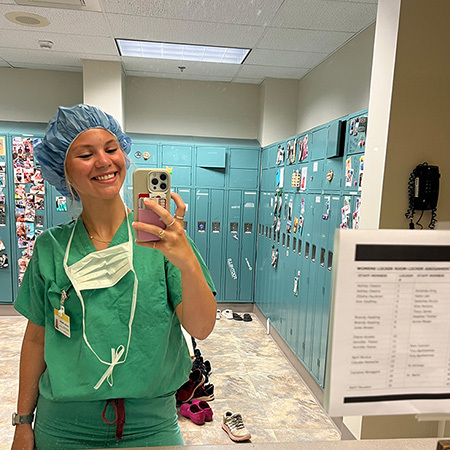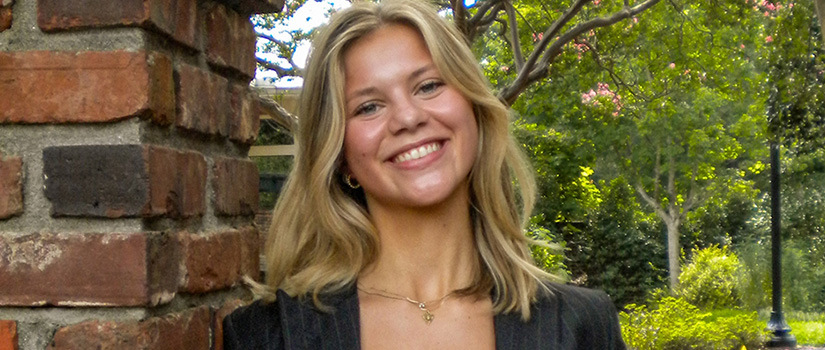In the College of Arts and Sciences, you can get involved with research as early as your first year on campus. But for some students, seizing the opportunities that come their way before starting at USC can lay the groundwork for remarkable success.
That was the case for Ansley Martin, a neuroscience major and incoming sophomore.
For the past two summers, Martin has participated in a research internship called the Structured Neuroimaging-Intensive Research Program, or SNIRP.
Run by Dr. John Absher, a neurologist at Prisma Health and professor at the University of South Carolina School of Medicine Greenville, SNIRP gave Martin the chance to work alongside college and medical students to analyze data on patients with brain injury and neurodegenerative diseases, like Parkinson’s and Alzheimer’s.
Martin got involved with SNIRP the summer before her freshman year, and she returned this summer as the program’s teaching assistant – a role she originated and funded through a stipend from the South Carolina Internship Program.

“The opportunity kind of naturally fell into my lap,” Martin says. “Going in, I had a little bit of neuro-anatomy background, but what really carried me through is that I had organizational skills and the ability to delegate from my experiences in student government in high school and now at USC.”
The leadership skills Martin developed in these roles have served her well in her research endeavors, starting last summer with SNIRP. Martin took the initiative to organize regular meetings and set benchmarks for her team’s progress, and her efforts helped them to be more successful.
During the school year, Martin continued to work on SNIRP research with collaborators from the program. Together, they have produced three papers and counting on their findings, which they have presented at conferences and Discover USC.
“One of the most interesting things we’ve found is that Parkinson’s has differences in certain biomarkers between male versus female patients,” she says. “Additionally, we submitted these findings for publication in the journal NeuroImage: Clinical and are awaiting review.”
Martin also found a mentor in Dr. Absher, who is a clinical associate professor at USC in Columbia. Knowing she wanted to return to SNIRP for 2024, Martin asked Dr. Absher to give her more responsibility.
“I knew he wanted to hire an administrative assistant, so I asked if he would create a teaching assistantship for the program,” she says. “I would do the same things I did last year, but this time for all the teams. That was how I became the TA.”
What made me successful in research initially was not my science background. It was the fact that I have experience in leadership. That’s why having people from diverse backgrounds is so important in research.
- Ansley Martin
Martin’s first job was to interview all 30 participants for this year’s program. She assigned them each to teams to take on three different research projects and appointed specific roles for each member.
She held regular meetings and prepared lectures on topics related to research and professional development in the sciences – topics like how to segment and analyze a brain MRI, how to write a review of scientific literature and how to seek mentors in scientific or medical fields.
Martin hopes her experience will inspire students to get involved with research even when trying something entirely new.
“It’s about assessing your skills and asking, ‘How can I apply those in a research setting?’” she says. “What made me successful in research initially was not my science background. It was the fact that I have experience in leadership. That’s why having people from diverse backgrounds is so important in research.”
After one year of college and two summers of research, Martin has found her stride as a premedical student and neuroscience researcher. In addition to her experience with SNIRP, she works with several other doctors and researchers, including USC’s Aging Brain Cohort and the McCausland Center at Prisma.
Next summer, she plans to pass the TA role on to a member of this year’s SNIRP cohort while she focuses on taking the MCAT and gets more experience in patient care settings.
Her biggest tip for other students: “Don’t be afraid of the no’s.” That outlook has driven Martin to take risks and ask for opportunities.
“It comes down to: what’s the worst that can happen? Someone can say ‘no.’ But the best-case scenario is that I make someone’s life a little bit easier and also do something I love, which is problem solving,” she says.
